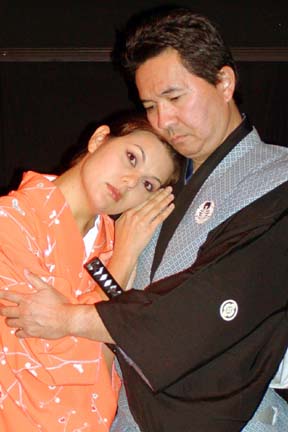
YELLOW BRICK STUDIO
Dorothy Stamp, left and Eric Nemoto star in "Ten Million Reawakenings," presented by The Actors Group.
Culture complicates
samurai love tale
A samurai's promise to his dying wife has horrific consequences in "Ten Million Reawakenings," the current change-of-pace production by the Actors Group in the Yellow Brick Studios. TAG co-founders Eric Nemoto and Dorothy Stamp are joined by Shaula Voge to form the romantic triangle that gives the story its foundation and its most vivid characters. Hawaii residents unfamiliar with the customs and social mores of Tokugawa-era Japan will be forgiven for not understanding the nuances of what happens as the story plays out.
Shimizu (Nemoto) marries Miya (Stamp), a woman of "low birth," against the wishes of his mother, Hahaue (Didi Leong). After a year or so of wedded bliss, Miya falls ill, and it is soon evident that she is dying. Miya asks her husband to bury her in the garden near the plum trees they had planted together and that she be buried with a mirror, a comb and a Buddhist pilgrim's bell. She tells Shimizu that she will wait for him forever and asks him to promise that he will not take another wife.
"Ten Million Reawakenings": Presented by the Actors Group at Yellow Brick Studio, 625 Keawe St., 7:30 p.m. Thursdays to Saturdays and 4 p.m. Sundays through Dec. 21. Tickets: $10. Call 722-6941 or tickets@taghawaii.org.
Shimizu promises on his honor as a samurai that he will do these things ("Never will I take another wife"), and Miya dies in peace with a slight smile on her face.
But Miya has died without producing a heir, and as time passes Hahaue badgers Shimizu about his responsibility to continue the family line so that the proper prayers can be said to honor their ancestors. Shimizu is eventually persuaded to marry Shino (Voge), and she moves into the house that has been dark and shrouded with gloom since Miya's death.
Shino tells Shimizu that she has heard a pilgrim's bell ringing in the garden and a terrifying woman comes to haunt her when he is away. Shimizu promises on his honor as a samurai that he will allow no harm to befall her.
Here's where things get complicated. The story is based on one "collected" in Japan by Lafcadio Hearn in 1901, but the TAG script is a contemporary creative collaboration by playwright Richard C. Goodman, director Brad Powell and cast member Nemoto. The ways in which their story might differ from the original folk tale are not revealed in the program notes; Americans unfamiliar with Hearn's collected works will remain unenlightened. Furthermore, Stamp gives such a beguiling performance in her death scenes, and Nemoto adds such a convincing portrayal of a stoic man wrestling with his emotions, that the enormity of Shimizu's promise to Miya, and the degree to which it would have run counter to the mores and morals of Tokugawa-era Japan, is pushed to the background and changes the balance of the story.
Voge plays Shino beautifully as an innocent and unworldly young woman who apparently wasn't told about Shimizu's promise to Miya. Shino is blameless -- and Voge looks adorable in an assortment of beautiful kimonos -- but romantic Americans are likely to see Shino as an interloper who causes Shimizu to break his promise to Miya.
A Tokugawa-era Japanese audience would weigh heavily how Shimizu is actually of peasant stock and was adopted into a samurai family so there would be a male heir to carry on the family name. Shimizu's decision to marry for love instead of political advantage would have been enough to mark him as a dangerously unpredictable individualist. What would a Tokugawa-era audience think of a man who owed his elevated position in life to his adoptive parents but refused to honor his mother's wishes that he produce an heir?
More problematic to the play as contemporary theater is TAG's desire to make it a grand cultural experience at the expense of the pacing and flow of the story. It could be a solid one-act ghost story, but the forward motion of the narrative is brought to a halt numerous times for lengthy dance segments that do nothing to advance the action or provide any additional insights into the characters. Lacking any explanation in the playbill notes, the audience gains no knowledge of the significance of the dances or the dancers' accouterments -- only that the story of Shimizu, Miya and Shino is repeatedly interrupted by the inscrutable dancing.
There are a couple of places where the elaborate cultural elements enhance the story. Dance is important when Shimizu meets Shino because it is her graceful dancing that catches his attention. A scene in which Miya changes from one kimono to another is explained in sufficient detail that some of the deeper meanings of her garments are revealed, and we understand that she may not be a conventional Japanese woman of her era. The carefully choreographed movement of the principal female actors -- Stamp, Voge and Leong -- is important in suggesting the time and place; Stamp also does a sufficiently frightening job as a koken ("invisible" stagehand) animating Miya's ghost in Act 2 to make the ghost scenes creditable.
And so, "Ten Million Reawakenings" provides a full two hours of entertainment for people familiar with the subtle nuances of Japanese dance, kimono design and Shinto and Buddhist religious practices, but would be more engaging as theater for the general public if most of the cultural segments were removed and used in a dance concert elsewhere.
To reveal the outcome of the story would be to spoil its impact, but the issues it raises end the tale on a memorable note.
Click for online
calendars and events.

